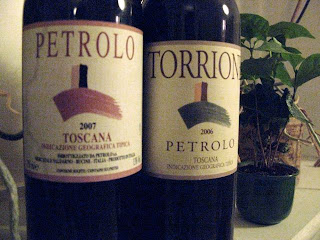As part of the foodbloggers symposium 2010 arranged by
Rasmus Holmgård, a winetasting with focus on Austria was later held one evening back in October. The event was supported by the Austrian Wine Marketing Board, to broaden the minds of danish food- and winebloggers to also include this lesser known corner of the European wine production.
The wines we tasted came in the following order:
Prager Riesling Smaragd Achleiten 2008, Wachau
This is one of the top producers of Austrian riesling and a very powerful wine to start out with. The lighting could have been better (it was quite dark), yet the wine appeared to have nice golden hue. In the nose it was mouthwatering with a remarkable blend of fruits, white flowers and minerals. In the mouth there was an immediate acid attack followed up by a plentiness of fruits that I have seldom tried before. The wine seemed a bit awkward in the mouth, a bit fat and the minerality was sort of hiding behind the other flavors. Still I have no doubt that this will develop into a magnificent wine in say 5-10 years from now. 92p
229 DKR., Bergman Vinimport
Wieninger Nussberg Alte Reben Gemischter Satz 2008, Wien
Whereas most wines from Austria are made from just one grape variety, this wine is a mix of several and thus called ”Gemischter”. Quite spicy in the nose, with some white pepper and lemon. There were the same elements in the mouth but also a green sort of unripeness that I was not particularly fond of. Plenty of minerals but not really a wine that tickles my fancy. 87p
130 DKR., Philipson Wine
F.X. Pichler Grüner Veltliner Smaragd ”von den Terrassen” 2005, Wachau
Yet again a top producer, but this time a wine made on the grape grüner veltliner. Lots of spices, including the trade mark of grüner veltliner -white pepper, and white fruit in the nose. Again I found a green unripeness in the mouth but also lots of minerals. 90p
189 DKR., Østrigsk Vinimport
Tement Zieregg Sauvignon Blanc 2008, Südsteiermark
This wine gave me green apples and vaseline!!!! (yep that is a first for me in a wine). Quite spicy and complex but seemed a bit unbalanced. 88p
251 DKR., Østrigsk Vinimport
Franz Strohmeier Schilcher ”Trauben, Liebe und Zeit” 2008, Weststeiermark
Very fresh and clean in the nose with lots of strawberries and red currant. In the mouth the first impression was a serious acid attack followed by same red fruits as from the nose. Lots of spices but the main focus is the mouthwatering acidity. An interesting rosé. 89p
127,50 DKR., Østrigsk Vinimport
Moric Blaufränkisch 2007, Mittelburgenland
Very pinot noir like in the nose, with dark raspberries and strawberries, but more spicy. The same in the mouth. No doubt that this producer has been thinking of Bourgogne while making this wine and it is a great success. For me this was the wine of the night although Prager came in a close second. 92p
260 DKR., Österreich
Claus Preisinger Pannobile 2007, Neusiedlersee
In contrast to the previous wine, this wine was much heavier with darker fruits and much more wood from the barrels. This is a well made wine that aims to please, and it does but I must say that I found it utterly uninspiring. 90p
245 DKR., Österreich
Alois Kracher No.8 Welschriesling TBA “Zwischen den Seen” 2001, Neusiedlersee
A trockenbeerenauslese made from welschriesling (which has nothing to do with riesling). Spicy clean nose. This is a very sweet wine but the acidity has a nice kick to it which keeps the wine on the straight and narrow. Plenty of tropic fruits like mango but also some caramel or burnt sugar. 92p
285 DKR., Bergman Vinimport
After the official tasting we had a number of great cheeses and more Austrian wines that did not take notes of. In all this event was a great success with plenty of opportunity to meet and talk to other food and wine fanatics.
/Mads
































